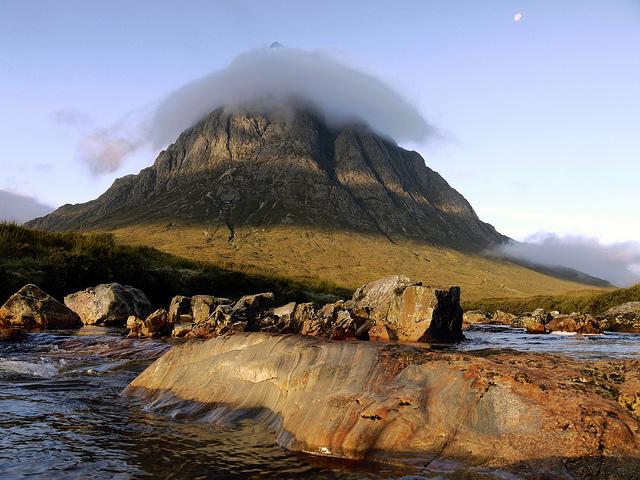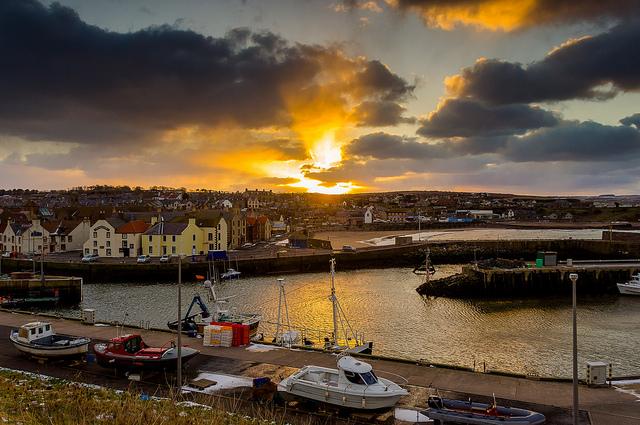Edinburgh
Although Scotland’s capital Edinburgh with its 483,000 habitants is less populated than Glasgow, it is the political center of the country. Amongst others, the Scottish Parliament has its domicile here. The most important attraction is the Edinburgh Castle in the center of the city. The castle area looks like a village with alleys where you find exhibitions. The Holyrood Palace is residence of the Queen when she visits the city during summer. Parts of the palace are open to the public and can be visited. Lots of beautiful pictures and paintings can be discovered at the National Gallery of Scotland. At the Royal Mile you can shop all kind of souvenirs while enjoying the historic atmosphere. For extensive shopping tours the Princes Street is the best place to go. Edinburgh is also famous for its festivals. The most popular ones are the Military Tattoo, the biggest music festival of the country with lots of military music, dancing and singing performances, and the culture festival Edinburgh Fringe.
Glasgow
With 595,000 habitants, Glasgow is the biggest city in Scotland and the third-largest of Great Britain. The city went through big changes. In the beginning it was characterized by shipping and trading, during the World Wars it has been an important place for the heavy industry. In the course of time lots of construction work took place, so that the city scenery looks much more modern today. Visitors can get in touch with locals while walking through the botanical garden. Stroll through the streets of the city and let the atmosphere of the buildings, which are mainly built with red or yellow sandstone, effect on you. Numerous galleries promise a rich cultural program. The Gallery of Modern Arts shows pictures and sculptures, the Kelvingrove Art Gallery offers art work in the biggest museum of Glasgow and at the Glasgow Science Center you can experience the world of technology. At the Lighthouse you can not only learn something about architecture, but also enjoy a stunning view of the city from the Macintosh Tower.
Aberdeen
In the north-east of Scotland you find the city Aberdeen. With 225,000 habitants it is the third-largest city in Scotland. It has the two nicknames “Silver City” and “Flower City”. The name Silver City was generated due to the many silver-grey granite houses that sparkle in the sun. The name Flower City is due to the numerous flower gardens. Many historic findings proof that the region around Aberdeen had been populated already 6,000 years BC. The city itself was mentioned for the first time in the 6th century. From there on many different quarters were formed and put together end of the 19th century. During a walk through the city you can discover many important buildings. The St. Machar’s Cathedral was built in the 12th century and is eye-catching due to its two west-stating towers. The eldest residential house of the city is the Provost Skene’s House which houses the local museum today. Other museums in Aberdeen are the Maritime Museum, which takes you to the world of seafaring and fishing, and the Blairs Museum that informs its visitors about the Catholic history of Scotland and the life of Maria Stuart.
Dundee
The fourth-largest city in Scotland is Dundee with 148,000 habitants. In the past the city was famous for jute industry. Jute was imported from India and handled with Whale-Oil so that a tight fabric was generated. Many companies had to close after the Second World War as there was a decrease in demand. Furthermore, the city is famous for its orange marmalade that was created by Janet Keiller. Unfortunately there are not many historic buildings in Dundee anymore as they were destroyed and damaged several times. Still well-preserved and open to the public is an old town gate, the St. Mary’s Tower, a leftover of the church St. Mary, and the Dudhope Castle from the 16th century. Worth-seeing are also the cemetery The Howff with the grave of the founder of the stamp, the Golf Museum, the Verdant Works Museum that informs about the history of jute, and the museum-ship RRS Discovery. A great view of the city can be enjoyed at the Dundee Law, a 174-meter-high volcanic cone.
Inverness
Inverness is located directly at Loch Ness and is the biggest city in the north of Scotland. The city is famous for the Inverness Castle which houses a court now. According to Shakespeare, this is the place where Macbeth killed his cousin Duncan I. The truth is that the murder took place during a battle close to Elgin. It is not possible to visit the castle, however, the castle park invites to a walk. Loch Ness is accessible via the river Ness that has, beside Loch Ness, a water mouth to Murray Firth that leads to the
North Sea. The river Murray with a length of 10 kilometers is one of the shortest rivers in Europe. You can do a boat trip to discover the surrounding area. During a stroll through the city of Inverness you can explore the historic buildings and churches. An eye-catcher is the town house with its colourful windows and emblems.
Perth
Perth, the former Scottish capital, is located in Central Scotland at the bank of the river Tay. In the 12th and 13th century the city traded with important countries, like France and the Netherlands, and was one of the richest trading cities in Great Britain. In medieval times Perth was known as “St. John’s Taun” as there is a local church honoring John the Baptist. The church St. John’s Kirk is open to the public today, but it is just a reconstruction and not the original church anymore. In the 20th century the church was rebuild, so that it looks like the one from medieval times. Another worth-seeing church is Scone Abbey that is located a bit outside of Perth. At this place the “Stone of Destiny”, where the kings and queens of Scotland were crowned, once has been. In the Fair Maid’s House, known from the novel „The Fair Maid of Perth“ written by Sir Walter Scott, you find the local museum today. An art gallery with works from J.D. Ferguson can be inspected at the old waterworks. Numerous parks, like the North Inch and South Inch are great places for extensive walks.
St. Andrews
At Scotland’s east coast, directly located at the North Sea, you find the small town St. Andrews. The university is the eldest one in the country and is known as university of the elite. One of the most famous alumni is Prince William. St. Andrew’s is also known as “Home of Golf”. The history of golfing already started in 1754 when the Royal and Ancient Golf Club of St. Andrews was found, which was one of the first golf clubs that existed so far. Very worth-seeing are the ruins of the cathedral St. Andrews from the 14th century that has been destroyed in the course of the Reformation. Since 1826 the remains have been restored. Today you can still imagine how big the cathedral must have been. At the same area you can visit the St. Rule’s Tower that is still well-preserved. From its top you have a great view of the town and the North Sea. Interesting museums are the St. Andrews Museum and the Preservation Trust Museum, which both provide lots of information about the history of the town.
Stirling
North-west of Edinburgh you find the town of Stirling. It is said that the surrounding area had already been populated in the Stone Age. The importance of the town grew during Roman times as the town had an ideal location on a hill with a good view of the river Forth. The harbour, once an important place for tea- and wood trading, was closed in the 20th century as ships could be loaded further downstream due to the construction of a rail bridge. This was much more profitable. Beside the Stirling Castle there are many other interested places that can be visited. Do not miss to take a look at the Cambuskenneth Abbey, a ruin with a clock tower, and the Wallace Monument, built in honor of William Wallace, the leader of the Scottish armed forces during the battle for the bridge of Stirling. The Stirling Old Bridge you can see it today, is not the original wooden bridge, but a rebuilt one that looks similar to the old one. A very pretty church is the Church of the Holy Rude at the end of St. John Street.
 © KENNETH BARKER / Flickr [CC BY 2.0]
© KENNETH BARKER / Flickr [CC BY 2.0]

